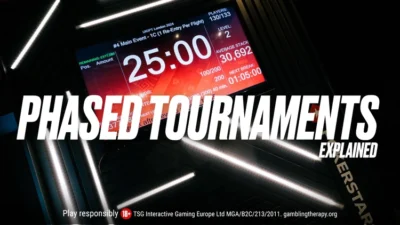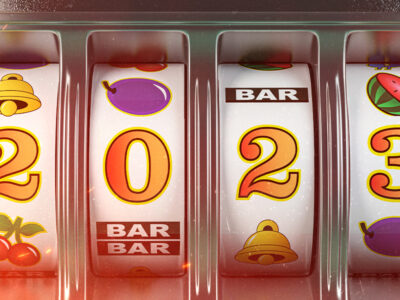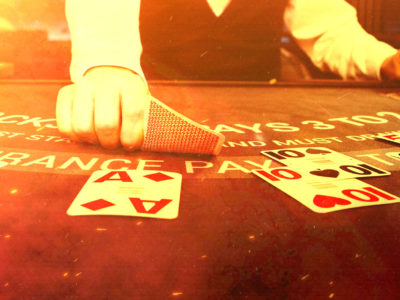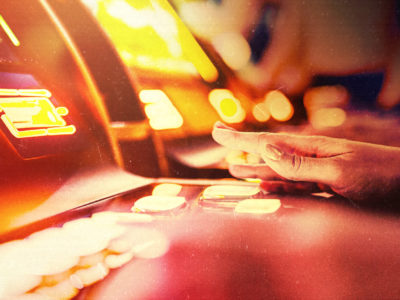In its most basic terms, a poker tournament works as follows: the player who gets all the chips wins.
There are many different tournament types, which take place live and online across the world, including many major tournaments on PokerStars. They have many differing numbers of players and offer a great variety of prizes. There are slight variations in structure too.
But that central essence is always the same: the player who gets all the chips wins.
Breaking it down slightly, here’s a more detailed explanation. At the start of a multi-table poker tournament (MTT), players exchange a set amount of money (the “buy-in“) for a set amount of chips (the “starting stack“), with which they then play hand after hand of poker. When a player wins chips, he or she adds them to his or her stack; when the player loses them, the chips go elsewhere.
When you lose your last chip, you’re knocked out. You’re eliminated. The game is over. It’s time to stand up and walk away. When all the players except one have been eliminated, the last player will have all the chips in the game and will be the champion. This player will also win the biggest prize.
PRIZES? I LIKE PRIZES
In tournament poker, once the buy-in has been paid, chips have no cash value anymore. They are simply tokens with which you play the game. Whether or not you win any money depends on how long you last in the tournament, and specifically whether you’re able to play on until the prizes start being handed out.
This is very different to how it works in a cash game.
Typically, around 10-20 percent of the players enrolled in a tournament will win some money, with those lasting the longest getting the most. Again, these are the kinds of things that can vary very slightly from tournament to tournament, but the principle never changes.
Tournament organisers — maybe an online poker site, or a casino operator — tally the amount of buy-ins they have received and announce a prize pool for the event. They will then also announce exactly how many players will receive some of the prize pool, and in what chunks. This payout structure is invariably top heavy, with the champion getting the most.
It also means that at a certain point in the tournament one player will be knocked out immediately before the money starts being handed out. This phase of the tournament is the “bubble“, with the player bursting the bubble universally regarded as the most unfortunate player around.
HOW LONG DOES A POKER TOURNAMENT LAST?
The duration of a poker tournament usually depends on its structure. Play is divided into “levels” of a pre-determined length, during which the mandatory blind bets are set at a pre-published amount.
The blinds increase at the end of every level, meaning each round of poker gets progressively more expensive to play. The chips of eliminated players remain in the game and sit with an ever-decreasing number of players, so the tournament leaders can usually withstand these blind increases thanks to their big stacks.
But short stacks find themselves increasingly under pressure as levels go by, and more and more people are knocked out.
It’s these simple mechanics that keep a tournament progressing towards its conclusion. Eventually, the blinds will get so big that no one will be safe. This applies no matter how many players sit down to play at the outset.
There are two critical factors that determine if a tournament has a fast or a slow structure: firstly, the length of the levels, and secondly, the steepness of the blind increase.
READ POKERSTARS SCHOOL’S BEGINNERS GUIDE TO POKER
In some tournaments, typically online, levels can last a matter of a few minutes as the blinds escalate rapidly. These will be known as “turbos” or even “hyper-turbos“. At the other end of the scale, some major live tournaments have levels that last more than an hour and have a blind structure that increases in tiny increments.
The $10,000 Main Event of the World Series of Poker (WSOP) in Las Vegas, for instance, plays out over more than two weeks. Partly that’s because of the size of the field, but mainly it’s because of the tournament’s incredibly deep stacks and slow structure. Players begin with a massive number of chips in relation to the size of the blinds, and then the blinds increase in tiny increments after levels that last two hours. It’s truly a marathon not a sprint.
HOW MUCH DOES A POKER TOURNAMENT COST?
One of the best things about poker tournaments is that players know at the start precisely how much it will cost them to play. The buy-in will be published clearly, and your buy-in gets you the same amount of chips as everyone else. No one gets more chips, no matter how much money they might be willing to splash, and you can never be bullied out of a pot purely by financial heft.
It’s also notable that tournament mechanics aren’t affected by the size of the buy-in. If you wanted, you could set up and play a tournament with the same structure as the WSOP Main Event and charge your friends $1 to play it. You could give them the same number of chips and use the same blind structure, changing only the buy-in. At a major poker festival, where numerous tournaments take place at the same venue at the same time, it’s not impossible for there to be two events playing simultaneously that have pretty much the same structure, but one costs about $300 to play while the other costs $5,000.
In the online game, tournaments can cost as little as 1 cent. (Sometimes they are even free, known as “freerolls“.) They can also have buy-ins of several thousand dollars. In the live arena, you’ll be hard pushed to find an organised tournament with a buy-in of less than about $50. Some of the biggest events have buy-ins of tens of thousands of dollars. So-called Super High Roller tournaments at PokerStars events can cost $100,000 to play.
HOW MANY PEOPLE CAN PLAY A POKER TOURNAMENT?
In normal circumstances, the only restriction on the number of players in a poker tournament is space. Much like you can’t invite 100 people to play a home game around your kitchen table, even the biggest casinos have a limited number of rooms in which they can host a tournament. Otherwise, it’s usually a case of the more the merrier. The higher the number of players, the bigger the prize pool. And that’s always a good thing.
Ready to sign up for PokerStars and play your first tournament? Click here to get an account.
Tournament fields spread across numerous tables. In most tournaments, players sit at tables of eight or nine players, against whom they play their hands. But everyone is part of a larger whole, and your immediate opponents may change more than once during the day. As players are eliminated, their seats become vacant and tournament organisers are therefore able to close down some tables, moving active players to fill the gaps that have appeared across the room. Tournament fields thus shrink as they progress: fewer players and fewer tables.
(Some tournaments are played as “six-max”, meaning there’s never more than six players seated at a table.)
One way of increasing the number of players able to play at the beginning is to spread a tournament across several starting days. In this model, a first batch of players sits down and plays the tournament’s opening levels on one day — let’s call it Day 1A — and anybody still with chips at the end of the day bags them up. Another batch of players arrives the next day — let’s call it Day 1B — and play starts again at Level 1. When that day is over, the remaining players bag their chips and wait for Day 2.
If necessary, there can also be Day 1C or Day 1D etc., but the idea is that all the survivors of the opening days — necessarily fewer than first started — return to play Day 2 together, when they can all fit.
Obviously the online game is not affected by problems of space. In the virtual realm, new tables can be opened to accommodate new players without any problem at all, and the escalating blind levels can make sure they are reduced at an appropriate rate to get things done. Players also move from one table to the next automatically as the tournament shrinks down.
WHAT ELSE DO I NEED TO KNOW?
In the conventional poker tournament model described above, players are eliminated when they lose their last chip. But to be specific that’s a freezeout tournament: each player receives only one stack of chips and when they’re gone, they’re gone.
Some tournaments offer one or more optional re-entry, which allows a player who has been eliminated to return to the cashier and buy-in again. (The player will receive only the same amount of chips as they would have at the start.) The player will be allocated a new seat and start over again.
The re-entry period (i.e., the length of time during which re-entry is permitted) will be advertised at the start of the tournament, after which point the tournament becomes a freezeout. Often the re-entry period will be known as “late registration” as players are also able to enter for the first time at any point during this period. There’s usually no obligation to sit down and start playing at the precise tournament start time. You can instead “late-reg” as long as entries are still open.
A rebuy tournament is slightly different. During the re-buy period, players who lose either all of their chips, or a pre-stated amount (usually more than half of their stack), can decide to “rebuy”. The player will receive another full stack, in exchange for another buy-in, but he or she will remain in the same seat. Rebuys usually need to be taken immediately. Players cannot get knocked out, walk away and then come back, as they can in a re-entry tournament.
You also need to know about the rake or fee. Tournament organisers don’t usually run the tournaments for free and instead charge participants for the privilege of playing. This covers the cost of dealers and floor staff as well as room rental, plus some profit for the company.
Sometimes the fee is advertised as an additional cost on top of the buy-in. For instance, an EPT Main Event is usually advertised as costing €5,000+€300 to play, where the €5,000 goes into the prize pool and the €300 is the fee. Other times, the tournament organisers will remove a certain percentage of the prize pool. Again, this should be stated clearly in advance.
HOW ELSE IS AN ONLINE TOURNAMENT DIFFERENT FROM A LIVE TOURNAMENT?
The mechanics of an online tournament are usually exactly the same as a live tournament. It’s just that the online game moves more quickly thanks to its automation. This allows online sites to run tournaments for tiny buy-ins, which would not be a cost-effective in the live arena, and for many more players to join.
It’s also almost always the case that an online tournament has a lower fee than a live tournament since the overheads for the organiser are lower.
You might also want to know a few things about strategy. As ever, PokerStars School is the best place to start for advice on playing tournaments. There’s a great number of considerations at various stages of the tournament, including the start, the bubble period, then hopefully the final table and short-handed.
There are hundreds of tournaments starting every day on PokerStars, so now you know the basics, it’s time to get involved.
Back to TopView Other Blogs






















